Abstract
Currently, the wood coatings industry is focusing on creating unique, vibrant finishes using new functional pigments. Simultaneously, there is a growing adoption of eco-friendly bio-based materials, reflecting trends in other sectors and supporting the circular economy. Thus, the aim of this study is to unveil a straightforward, cost-effective, and notably sustainable process for exploiting the coloring potential of turmeric powder and coloring polyamide 11-based fillers, employed as multifunctional pigments for wood coatings. Through the incorporation of this additive into a wood paint, the study demonstrates its dual effect of enhancing the aesthetics of the final composite layer while leveraging the beneficial protective properties inherent to polyamide 11. The impact of these additives on sample aesthetics is assessed through optical observations, as well as measurements of color, gloss, and surface roughness. The strengthening contribution of the functional pigment is evaluated using the Taber abrasion resistance test, static friction coefficient measurements, and Buchholz surface hardness test. Finally, the aesthetic consistency of the bio-based filler and the coloring efficiency of the sustainable process are tested by subjecting the samples to aggressive conditions, including the UV-B chamber exposure test, cold liquids resistance tests, and water uptake test. Ultimately, the study illustrates how this functional bio-based pigment not only provides sufficient protection but also meets current eco-requirements, thereby contributing to the sustainability of the wood coatings industry.
1. Introduction
Presently, coatings are anticipated to provide sufficient protection to the underlying substrate [] while also enhancing its visual appeal []. Nonetheless, there is a growing need for coatings to offer multiple functionalities [], beyond basic protection and aesthetics. This trend is not only prevalent in coatings for metals substrates [] but also gaining significant attention in the field of wood coatings [].
Indeed, wood requires careful protection against various threats such as solar radiation [], moisture infiltration [], mechanical damage [], chemical-induced deterioration [], and harmful microorganisms like fungi []. Protective coatings play a crucial role in mitigating the physical and chemical deterioration of wood’s lignocellulosic elements caused by these factors. Researchers have focused on enhancing the protective properties of wood coatings by incorporating specific functional additives []. For example, metallic and ceramic nanopowders have proven effective in shielding against UV radiation [] and enhancing wood’s hardness and stiffness [] while reducing water absorption within the coating []. Additionally, metallic nanomaterials have been employed to impart efficient antibacterial and antifungal functions to the coating [].
At present, while wood’s innate beauty has long been appreciated [], there is also a growing focus on creating unique and visually captivating finishes. This trend is evident in the contemporary wood coatings industry, where there is a particular emphasis on achieving vibrant color tones [] through the exploration and development of new functional pigments [].
Nevertheless, mirroring trends in other industrial sectors, the wood industry is concurrently increasingly turning to the use of bio-based materials [,]. These innovative materials are sought to be environmentally friendly and in line with the principles of the current circular economy. However, the adoption of bio-based materials often presents significant challenges regarding the protective performance, durability, and color consistency of green pigments themselves []. Wood paints made from bio-based materials often lack sufficient hardness and abrasion resistance [], requiring the addition of specific reinforcing fillers to improve these properties [,]. On the other hand, bio-based pigments frequently exhibit inadequate resistance to common phenomena like photo-oxidation and decay when exposed to UV radiation [,]. As a result, their use as additives in paints for outdoor applications is highly limited [].
Considering the multifunctional aspects guided by the principles of the circular economy, two recent studies [,] stand out regarding the application of green additives for wood paints. One study explores the use of polyamide 11 powder as an eco-friendly and functional filler for wood paints, capable of enhancing various mechanical properties of the composite layer []. The micrometric powder, derived entirely from renewable sources such as castor oil, demonstrates remarkable dimensional stability and offers impressive impact and abrasion resistance properties []. In contrast, another research highlights the interesting coloring contribution of turmeric extracts, utilized as a natural resource [].
Turmeric, scientifically known as Curcuma L. and belonging to the Zingiberaceae family, encompasses approximately 93–100 species []. The rhizome, which is the commonly utilized part of the plant, contains the primary active components, including non-volatile curcuminoids and volatile oil []. Curcuminoids, which consist of curcumin, demethoxycurcumin, and bisdemethoxycurcumin, are polyphenolic derivatives found in the rhizome. These compounds are non-toxic and exhibit a wide range of biological activities []. They serve as the main coloring compounds of turmeric [,], capable of imparting an intense yellow hue to various substances. Therefore, curcumin can effectively serve as the vibrant yellow element for applying non-toxic, bio-based organic dyes to wood coatings []. However, the large size of the turmeric granules can pose critical issues, including aesthetic inconsistency and potential defects in the coating.
Hence, the concept behind this research revolves around the possibility of synergistically using the two additives—polyamide 11 and turmeric powders—to create a single multifunctional, colorful, and protective filler. Specifically, the study aims to harness the coloring potency of turmeric by directly tinting polyamide 11 powder.
Although the extraction and isolation of curcumin from turmeric powder were first reported in 1815 [,], more refined and advanced extraction techniques continue to emerge, even centuries later [,,]. However, many of these methods often rely on the extensive use of organic solvents [,,], which are not environmentally friendly, or employ processes with high energy consumption rates, such as pulse ultrasonic and microwave-assisted extraction methods [,,], or temperature-based processes []. An alternative approach, which has been under study for a century [], involves the synthesis of curcumin [,]. However, even in this scenario, the processes tend to be intricate and not particularly sustainable [,].
Therefore, the aim of this study is to showcase the feasibility of utilizing the pigment extracted from turmeric to color polyamide 11 powder via a straightforward process that does not necessitate intricate systems or chemical reagents. The goal is to employ turmeric as a natural dye resource without compromising the eco-sustainability of the process. Additionally, this research aims to illustrate how the colored polyamide 11-based filler can effectively fulfil its strengthening role in wood paint applications.
2. Materials and Methods
2.1. Materials
The polyamide 11 (PA11) powder, branded as Rilsan® D30 NAT, was provided by Grolman Group (Merate, LC, Italy) and utilized as received. This product is in the form of a white powder comprising granules typically sized between 21 to 27 µm. The polymer boasts a melting point of 186 °C and a density of 0.34 g/cm3. The turmeric powder was supplied by Garzanti Specialties (Milan, Italy) and used in its original form. It was derived from matured rhizomes of Curcuma longa L., which underwent processes including drying, cleaning, grinding, screening, and inspection for any metal contaminants. The manufacturing process involved steam sanitization, meticulously regulating pressure, temperature, and treatment duration. The resulting turmeric powder consists of granules sized 100% through 40 mesh (<420 µm) with a density of 0.60 g/cm3. The composition, as provided by the supplier, primarily includes ash (10.0 wt.%), curcumin (3.0 wt.%), and insoluble acid ash (2.5 wt.%). Poplar wood panels, measuring 150 × 150 × 2 mm3, were procured from Cimadom Legnami (Lavis, TN, Italy). These panels have a density ranging from 0.40 to 0.42 g/cm3 and a moisture content falling within the 6% to 9% range. Poplar plywood was chosen as the substrate for paint application due to its well-regarded reputation for exceptional quality compared to other panel materials []. Its smooth surface makes it ideal for painting, laminating, or veneering purposes []. Additionally, its ease of machining, particularly its reputation for effortless cutting, sanding, or screwing, renders it a preferred choice for preparing various samples intended for characterization tests. The water-based acrylic paint, TECH20, was procured from ICA Group (Civitanova Marche, AN, Italy). This paint formulation is derived from materials obtained from sustainable and renewable sources. The product has a specific weight ranging from 1.01 to 1.18 g/mL and a viscosity of 50–60 s Ford Cup 5 (as specified by the manufacturer).
2.2. Filler Coloration
The process for coloring the polyamide 11-based filler using turmeric powder as a dying resource is illustrated in Figure 1a. Consistent with the aim of the study, the procedure employed is notably simple and, most importantly, sustainable in terms of costs, time, and environmental impact.

Figure 1.
(a) Illustration depicting the procedure for isolating dye from turmeric and applying it to color PA11 powder and (b) visual representation of turmeric powder, PA11 powder, and tinted PA11 powder (slightly diluted in water).
The initial step of the process involves extracting the colorant from the turmeric powder, which only requires demineralized water, a standard laboratory magnetic stirrer, and a laboratory centrifuge. Specifically, a 1 wt.% aqueous solution of turmeric is stirred for 24 h at room temperature. This duration allows the turmeric powder to release a substantial dye content, thereby coloring the solution. The procedure was fine-tuned by optimizing the mixing duration of the mixture. The efficiency of the process was validated through several trials while maintaining the weight percentage (wt.%) of turmeric constant at 1% but varying the mixture volumes. Subsequently, the mixture is centrifuged to remove the solid residue (turmeric powder) and retain the resulting yellow liquid. To ensure the complete separation of the solid content from the colored liquid, the mixture underwent three centrifuge cycles, with each cycle lasting 2 min at 4500 rpm.
Hence, the second step of the process involves coloring the polyamide 11 powder. To accomplish this, the PA11 powder was introduced into the colored solution obtained from the first step, in an equal weight quantity as the initial turmeric powder. In this instance, the mixture was continuously stirred for 48 h at room temperature (25 °C) to facilitate the penetration of the yellow dye into the microporosity of the PA11 powder, thereby coloring its structure. Subsequently, the mixture underwent three centrifugation steps, each lasting 2 min at 4500 rpm, using demineralized water to ‘wash’ the residue of colored PA11 powder.
Figure 1b depicts the macroscopic appearance of the turmeric powder, the initial PA11 powder, and the outcome of the coloring process, namely the yellow colored PA11 powder. The yellow colored PA11 powder is slightly diluted in water to prevent granule clumping after complete drying.
To optimize the powder coloring process, the procedure was investigated by altering the weight ratio between the turmeric powder utilized in the first step and the PA11 powder added to the colored solution in the second step. Figure 2 displays the appearance of the powders obtained using turmeric-to-PA11 weight ratios of 0.1:1 (Figure 2a), 1:1 (Figure 2b), and 10:1 (Figure 2c), as observed under an optical microscope (Olympus DSX1000, Tokyo, Japan). As anticipated, the PA11 powder exhibits a more pronounced yellow color as the initial quantity of turmeric increases. The 0.1:1 ratio (Figure 2a) does not appear optimal, as the powders do not exhibit significant coloring; the turmeric powder content is insufficient to release enough dye to substantially color the PA11 powders. On the other hand, the difference between the powders in Figure 2b,c is not very evident, indicating that it is unnecessary to use excessively large quantities of turmeric to effectively color the bio-based filler. Consequently, the turmeric-to-PA11 ratio of 1:1 was deemed optimal to prevent unnecessary wastage of turmeric powder, as further increasing the ratio does not significantly enhance the chromatic consistency of the final filler. These considerations justify the decision to utilize the same weight quantity of turmeric and PA11 in both steps of the filler coloring process.
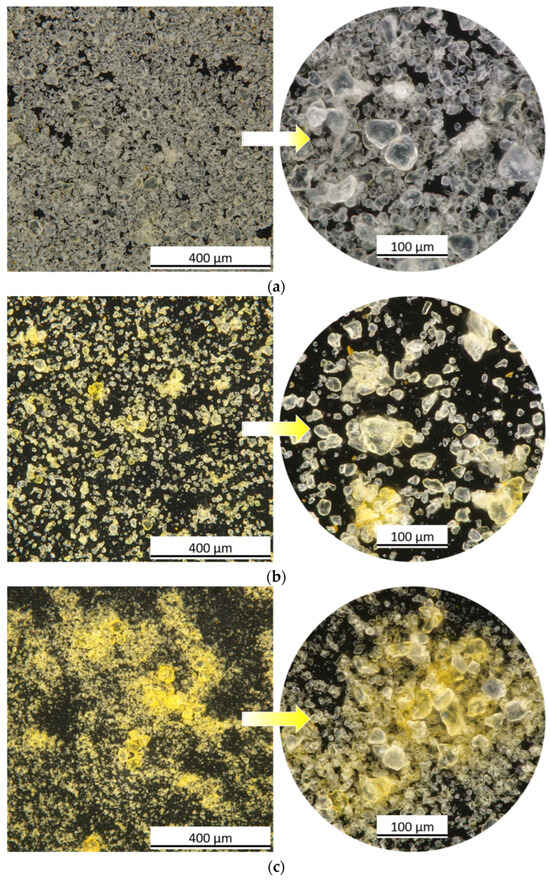
Figure 2.
Optical micrographs (280× and 700×) showing the appearance of the colored PA11 powder employing turmeric-to-PA11 weight ratio of (a) 0.1:1, (b) 1:1, and (c) 10:1.
2.3. Samples Production
The colored PA11 powder was subsequently evaluated as a filler and functional pigment in a clearcoat wood varnish. Specifically, 4 wt.% of PA11 powder was incorporated into the paint, which underwent mechanical mixing for 30 min to ensure a homogeneous distribution of the bio-based additive, preventing any sinking or floating phenomena. The selection of a 4 wt.% content of the PA11-based additive was deemed adequate to achieve a vibrant color in the paint without risking the occurrence of defects. Additionally, previous research on the reinforcing properties of PA11 powder suggested that a filler quantity exceeding 10 wt.% should be avoided []. This series of samples has been renamed to PC.
To ensure that the coloring process of the powder does not impact the properties of the PA11-based filler, a comparison sample labeled as P was prepared, containing the same quantity (4 wt.%) of bio-based additive but not subjected to coloring procedure. Similarly, another series of samples labeled as C was created, containing the same quantity of turmeric powder, to conduct a purely aesthetic comparison between the coloring powder (turmeric) and the colored powder (colored PA11). In both cases, the paints were mixed for 30 min, as previously described, to ensure effective dispersion of the pigments and additives. Finally, the performance of these 3 series of composite coatings was compared with the outcome of the sample defined as R, which serves as a reference. The R series was made with the clearcoat paint without the addition of further additives. This series of samples helps to better illustrate the different behaviors of the individual turmeric, PA11, and colored PA11 powders added to the coatings C, P, and PC, respectively.
Prior to applying the 4 series of coatings, the wooden substrate underwent a preparation step, which included smoothing the surface using 320 grit paper to ensure even paint distribution. After this process, the paint was sprayed onto the surface according to the supplier’s guidelines, applying a pressure of 3 bar and a material rate of 100 g/m². Following the application, the coated surface was allowed to air dry for 4 h at room temperature (25 °C) and relative humidity RH of 50%, to complete the curing process. The paint application and drying procedure was repeated once more to achieve the ultimate coating.
Table 1 presents the four series of samples along with their respective nomenclature and the type of green additive incorporated within each series.

Table 1.
Samples composition with relative nomenclature.
2.4. Characterization
Besides examining and describing the appearance of the powders and composite layers, the study thoroughly investigated how the bio-based colored filler affects the coatings’ abrasion resistance, surface friction, hardness, durability, and barrier performance.
In particular, the optical microscope Olympus DSX1000 (Olympus, Tokyo, Japan) and scanning electron microscope SEM JEOL IT 300 (JEOL, Akishima, Tokyo, Japan) were employed to examine the visual characteristics and structural features of the 3 bio-based additives. The aesthetics of the coatings, with a focus on the influence of the 3 different additives on the final appearance, were evaluated using an optical stereomicroscope, the Nikon SMZ25 (Nikon Instruments Europe, Amstelveen, The Netherlands). Additionally, colorimetric analyses were carried out using a Konica Minolta CM-2600d spectrophotometer (Konica Minolta, Tokyo, Japan) with a D65/10° illuminant/observer configuration in SCI mode. Gloss measurements were conducted using an Erichsen 503 instrument from Erichsen Co.Fo.Me.Gra Instruments (Co.Fo.Me.Gra, Milan, Italy), following the ASTM D523/14 standard []. Surface roughness was assessed using the MarSurf PS1 mobile surface roughness measurement instrument from Carl Mahr Holding (Gottingen, Germany). A total of 25 evaluations for color, gloss, and roughness were performed, with 5 samples analyzed per series and 5 measurements taken per sample. Furthermore, SEM was utilized to investigate the cross-sections of the coatings, providing insight into the impact of the different additives on the structure of the composite layers.
The influence of the bio-based additives on the mechanical properties of the polymer matrix was evaluated through various tests. Taber abrasion test was conducted on 5 samples per series (100 × 100 × 2 mm3) using a TABER 5135 Rotary Platform Abrasion Tester (Taber Industries, North Tonawanda, NY, USA) following ASTM D4060-10 standard guidelines []. This test utilized two CS17 abrasion wheels with a total weight of 0.5 kg, subjecting the samples to 3000 Taber cycles while monitoring mass loss. Color and gloss changes were observed throughout the test to assess the evolution of the coatings’ aesthetics.
Additionally, the static coefficient of friction (COF) for the coatings was determined using a setup similar to previous studies [,]. A weight of 0.5 kg was applied to the samples, and they were pulled using a dynamometer at a speed of 0.1 cm/s. The force required to move the sample was measured to calculate the COF. The test results represent the average of five measurements conducted for each series of samples (100 × 70 × 2 mm3).
Finally, the impact of the additives on the coatings’ hardness was examined using the Buchholz hardness indentation test, following the ISO 2815 standard []. An Elcometer 3095 Buchholz Hardness Tester (Elcometer, Manchester, UK) was used, applying a consistent testing force of 0.5 kg for 30 s on the coating surface. The extent of the impression made by the standardized instrument provided an indication of the coatings’ hardness. Fifteen measurements were performed on 5 samples per series (with 3 measurements per sample).
To assess the color uniformity of the coatings, accelerated degradation tests were conducted by exposing the samples to a UV chamber for 50 h. The UV173 Box Co.Fo.Me.Gra (Co.Fo.Me.Gra, Milan, Italy) was utilized in accordance with ASTM D4587-11 standards []. This involved subjecting the samples to UV-B radiation (313 nm) at a temperature of 60 °C. Colorimetric and gloss analyses were performed throughout the exposure period to examine the impact of specific additives. The standard requires the use of strong UV-B radiation, which mimics only part of the solar radiation exposure experienced by the samples. However, this specific test was selected to emphasize the importance of understanding the physical and chemical degradation of the bio-based pigment caused by solar radiation, using a particularly rigorous and accelerated approach. The exposure was stopped at 50 h because significant degradation was observed in the samples, and the color change reached a plateau.
The integration of bio-based fillers aimed to provide distinct coloration to the coating while enhancing its mechanical resilience. However, to ensure that these additives do not compromise the coating’s protective properties, the samples underwent different tests.
The cold liquid resistance test, following UNI EN 12720 standards [], evaluated the coatings’ resistance to various chemical substances. Filter paper was immersed in separate solutions containing 15% sodium chloride, pure acetone, olive oil, and coffee (40 g/L of powder coffee). Additionally, the coatings’ resistance to acidic and basic conditions was tested using solutions with pH levels of 1 and 14, respectively, prepared with concentrated HCl and NaOH. The soaked filter papers were then placed on the coating surface, covered with a glass lid, and left for 24 h. Afterward, the glass cover and filter paper were removed, and any remaining liquid on the coating surface was carefully removed.
Finally, the liquid water absorption test, conducted according to EN 927-5:2007 standards [], evaluated the coatings’ water permeability. Five uncoated surfaces of 40 × 40 × 2 mm3 poplar wood panels were sealed with silicone to prevent water absorption. These samples were preconditioned at 65% relative humidity and 20 °C before immersion in water. Moisture absorption, expressed in grams per square meter (g/m2), was measured by recording the change in mass after 5, 25, 50, 75, and 100 h. Both the cold liquid resistance test and the liquid water absorption test were accompanied by color and gloss measurements to assess the coatings’ aesthetic consistency.
3. Results and Discussion
3.1. Additives and Coatings Appearance
The images depicted in Figure 3 display the visual characteristics of the three powder variants utilized in coating formulation. These observations were conducted using both an optical microscope and SEM, with magnified views provided on the right for enhanced detail. Figure 3a illustrates the appearance of turmeric powder employed in sample C. This resource exhibits highly variable dimensions, encompassing powders ranging from a few µm to granules exceeding hundreds of µm in size. While the granule sizes exhibit significant variation, they generally fall within the manufacturer’s specified range of 400 µm or less, as indicated in the technical data sheet. However, larger granules could potentially pose challenges and serve as sources of defects in the paint, particularly if their size approaches that of the final coating’s thickness. Notably, the granules showcase a highly irregular shape, as emphasized by the SEM focus: the powder displays predominantly regular granules, along with bodies featuring distinctly jagged geometries, characteristic of organic additives of vegetal origin []. The color, discernible from the optical microscope images, manifests as a vibrant and luminous orange, typical of the turmeric utilized in the powder’s production. Figure 3b depicts the visual characteristics of PA11 powder. This powder lacks color, presenting macroscopically as white granules. Similarly to the turmeric by-product, the geometry of the PA11 powder is not precisely defined, albeit exhibiting a somewhat more regular shape. As outlined in the technical data sheet, the granules typically possess an average size ranging from 20 to 30 µm, although instances of granules nearing 50 µm in size are not uncommon. The FTIR infrared spectra of the two bio-based additives, namely turmeric and PA11 powders, are not included in this study, as they have been thoroughly discussed in prior research [,]. Finally, Figure 3c illustrates the visual presentation of PA11 powder following the coloring process previously outlined and schematically depicted in Figure 1a. Notably, the process applied did not alter the morphology of the PA11 powder, as evident from a comparison with Figure 3b. However, it is evident that the granules have acquired a yellow hue through the sustainable coloring process, particularly discernible in the macro image captured by the optical microscope (left). Clearly, the granules do not showcase the vivid orange hue of the original turmeric, as the coloring process involves a restricted extraction of pigments from the turmeric powder. Previous experiments conducted on various ratios of turmeric-PA11, as depicted in Figure 2, have underscored the impossibility of achieving an identical color match to the turmeric powder, even with significantly increased utilization of the latter in the coloring process. Consequently, the resulting product of this process comprises yellow powders, which have assimilated only a fraction of the pigmentation inherent in turmeric (as already evidenced in the image presented in Figure 1b). Indeed, there is a noticeable transformation in the color of the PA11 powder, transitioning from white to a vibrant yellow when observed at a macroscopic level. Consequently, this newfound aesthetic characteristic can be leveraged to utilize the powders as active fillers for paints, introducing an additional coloring functionality to the formulation.
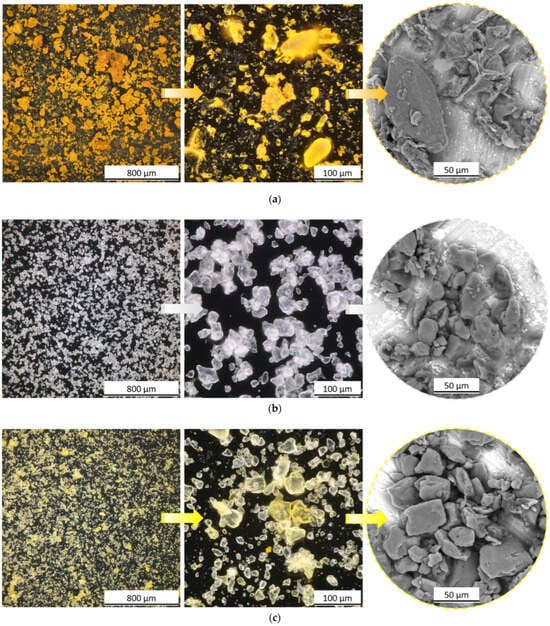
Figure 3.
Optical micrographs displaying the visual characteristics of (a) turmeric powder, (b) PA11, and (c) colored PA11, along with their corresponding morphological structures observed via SEM (on the right).
Subsequently, the three types of powders were incorporated into the acrylic paint to assess their potential functionality. The appearance of the resulting samples is depicted in Figure 4a, showcasing distinctly varied characteristics among the four coatings, largely influenced by the type of filler contained within each. Contrasting with the reference sample R, the inclusion of turmeric imparts the characteristic orange hue to sample C, albeit with noticeable presence of several notably large bio-based granules, as anticipated. Conversely, PA11 powder seems to have minimal impact on the color of coating P (as they are transparent), yet they appear to enhance its opacity. Lastly, sample PC showcases a vivid yellow shade, attributed to the color acquired from the PA11 powder during the sustainable coloring process. To quantify the aesthetic differences among the four series of coatings more precisely, colorimetric measurements were performed on the samples. Figure 4b presents the values of the three color coordinates L*, a*, and b*. These coordinates represent distinct color attributes as follows:
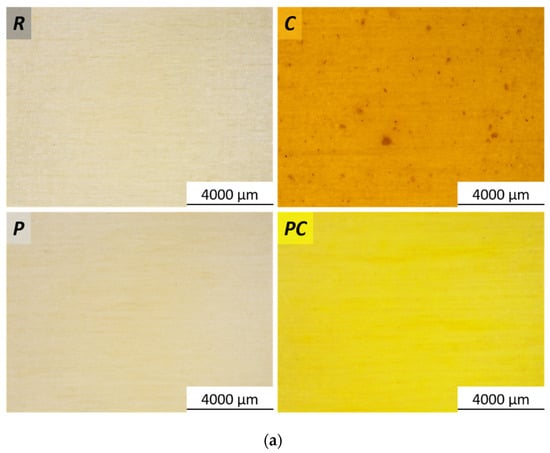
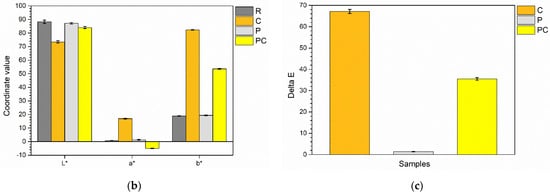
Figure 4.
(a) the visual aspect of the four series of samples, (b) their respective color coordinates L*, a*, and b*, and (c) the ΔE of the three composite coatings respect to the reference sample R.
- L* signifies lightness, ranging from 0 (for black objects) to 100 (for white objects);
- the a* axis indicates the red-green axis, with positive values denoting redness and negative values indicating greenness;
- the b* axis represents the yellow-blue axis, where positive values indicate yellowness and negative values indicate blueness.
The coordinate L* doesn’t exhibit significant influence from the various fillers; a small decrease (from 88.3 ± 1.2 to 73.4 ± 0.8) is observed primarily with the addition of turmeric powder, which tends to darken the coating. Consequently, the lightness of the coating remains largely unaffected by the presence of PA11 content, even after the introduction of yellow coloring (L* of 84.0 ± 0.8 in sample PC). Conversely, the addition of fillers with specific colors notably impacts the values of the coordinates a* and b*. Turmeric introduces intense red tones, but notably yellow tones as well (values of a* and b* equal to 16.9 ± 0.3 and 82.3 ± 0.2, respectively), shifting the perception of color towards hues of orange. On the other hand, the colored PA11 powder leads to a reduction in the a* coordinate towards slightly green shades (−4.9 ± 0.2), but notably increase the b* coordinate towards yellow hues (53.6 ± 0.4). Despite sample PC exhibiting lower b* values compared to the corresponding sample C, the latter appears less yellow but more orange due to the significant influence of the red component of the a* coordinate. Finally, the transparent PA11 powder further confirms its minimal influence on the color of the acrylic matrix within the coating. This is evidenced by the nearly identical values of the three coordinates observed in samples R and P.
To highlight the chromatic impact of the bio-based additive, the color change ΔE of the three composite coatings compared to the reference sample R was assessed. This was calculated using the following formula []:
ΔE = [(ΔL*)2 + (Δa*)2 + (Δb*)2]1/2
The outcome of this analysis is depicted in Figure 4c, effectively showcasing the quantitative measure of the color change induced in the coating by the turmeric powder and colored PA11. While sample P exhibits a color change of approximately one unit compared to the pure acrylic matrix layer, samples C and PC demonstrate ΔE values of approximately 67 and 36 points, respectively. These two values indicate significant aesthetic alterations, as evidenced in Figure 4a, particularly noteworthy considering that the human eye can perceive color changes of approximately 1 point [,]. Hence, turmeric exhibits a potent coloring ability, proving its simple partial transferability to PA11 powder, which can effectively function as a functional pigment in the paint.
However, the aesthetic function of this pigment extends beyond the simple modification of the color of the coating; it also influences the reflectance properties of the composite layer. In this regard, Figure 5a illustrates the gloss values measured in both the longitudinal (//) and perpendicular (⊥) directions to the fibers of the wooden substrate. The results depicted in the graph should be correlated with the roughness outcomes, specifically the Ra values measured in the same two directions, as illustrated in Figure 5b. The reference sample R exhibits high reflectance, particularly noticeable in the longitudinal direction of the wood fibers. However, this phenomenon diminishes in the perpendicular direction due to a natural elevation in surface roughness of the coating, which tends to conform to the morphology of the wooden substrate. On the other hand, the inclusion of turmeric in sample C results in a notable decrease in gloss values in both directions (≈50 and ≈25 units in directions // and ⊥, respectively). This decrease is associated with a significant rise in surface roughness (≈1.5 and ≈1.1 µm in directions // and ⊥, respectively), primarily attributable to the presence of large granules of bio-based pigment. Consequently, while turmeric imparts an intense color to the coating, it concurrently diminishes its gloss due to substantial alterations in the surface texture of the composite layer. The incorporation of PA11 powders, whether colored or not, yields a similar outcome: gloss values decrease in both directions (≈50 and ≈25 units in directions // and ⊥, respectively), resembling the effect observed with turmeric. However, the impact on roughness values is more moderate (increase of ≈1.0 and reduction of ≈0.4 µm in directions // and ⊥, respectively). In this scenario, the PA11-based filler does enhance the surface irregularity of the layer, yet the aesthetics of the coating are primarily influenced by the inherent opacifying characteristics of the polyamide 11 powder (whose granules actually appear very opaque). Hence, the bio-based filler can introduce a distinct yellow hue to the coating, following the coloring process, while also impacting its opacity and reflectance values. Importantly, this is achieved without significantly altering the surface texture of the coating. These initial analyses underscore how the additive can serve as a functional filler possessing commendable aesthetic properties.
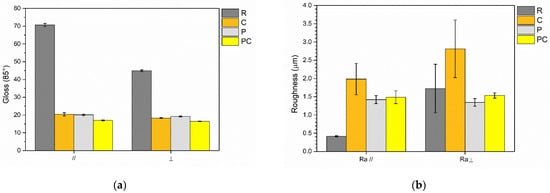
Figure 5.
(a) gloss values of the samples measured longitudinally (//) and perpendicularly (⊥) in relation to the fibers of the wooden substrate and (b) the corresponding roughness values in both directions.
However, to assess the compatibility between the fillers and acrylic matrix, the coatings were observed in cross-sections, following brittle fracture performed in liquid nitrogen. Figure 6 presents the four sets of samples, examined under both optical microscope (left) and SEM (right). The coatings exhibit comparable thickness, ranging between 200 µm and 250 µm, also influenced by the roughness of the substrate. The cross-section of coating R (Figure 6a) displays the characteristic jagged morphology typical of a fractured organic layer []. Sample C (Figure 6b) demonstrates a similar outcome, albeit with the notable presence of large turmeric granules of variable size, perfectly sectioned due to the treatment in liquid nitrogen. In contrast, the presence of PA11 powders in coatings P and PC (Figure 6c and Figure 6d, respectively) results in the formation of a notably intricate fracture surface. Due to their high strength [], PA11 powders often remain intact within the coating section or are expelled during the brittle fracture process without being sectioned, unlike turmeric. Fracture within the layer predominantly occurs at the matrix-PA11 interface rather than through the tough powder. However, this phenomenon does not indicate poor surface energy between the filler and acrylic surface. In fact, many powders remain partially anchored to the polymeric matrix, indicating excellent compatibility with the acrylic resin. Moreover, considering the significant quantity of filler with variable size, particularly in comparison to the layer thickness, relying solely on section observations may not be adequate to ensure the uniform distribution of PA11 powders. Nonetheless, the consistent color of the paint without any apparent sinking or floating of particles, along with the consistent appearance of the coatings even through top-view observations, strongly suggests a homogeneous distribution of the filler within the coatings.
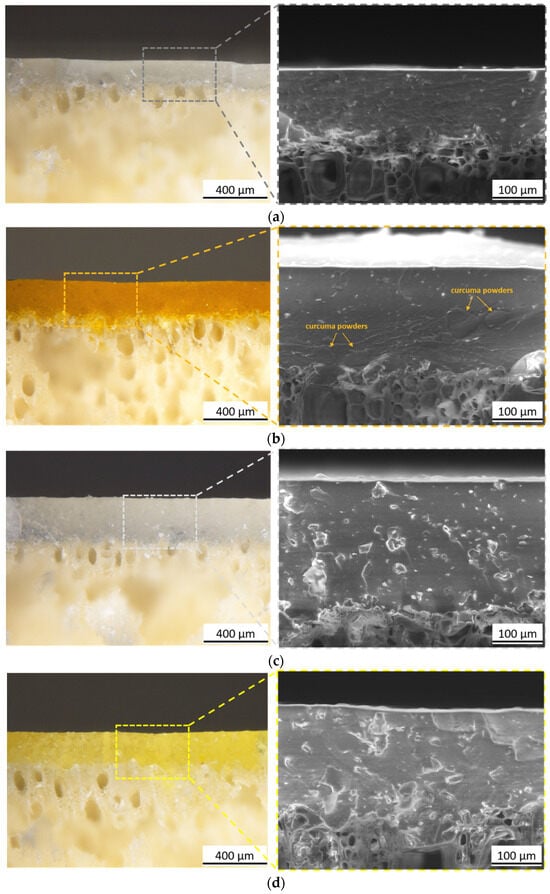
Figure 6.
Optical micrographs depicting the layer cross-section (left—72×) and a focused view of the bulk morphology observed under SEM (right—250×) for (a) sample R, (b) sample C, (c) sample P, and (d) sample PC.
In conclusion, these analyses underscore the aesthetic outcomes achieved by incorporating colored PA11 powder as a functional pigment in wood paints. While turmeric imparts intense coloration, its variable and large granule size induce morphological alterations in the coating, potentially leading to defects. Conversely, colored PA11 powder induces a specific color change in the coating, serving as a bio-based pigment, while also acting as a matting additive to enhance aesthetic properties without altering the roughness of the final layer. Moreover, the powders exhibit good compatibility with the acrylic matrix, a critical property for the protective functions of the filler.
3.2. Effect of the Coloring of the PA11-Based Additive on Its Strengthening Properties
PA11 powders have previously demonstrated the ability to enhance the mechanical properties of coatings, including improved abrasion resistance and reduced friction coefficient [], and impressive impact resistance characteristics [,]. Consequently, the samples underwent various tests to ascertain that the sustainable coloring process did not compromise the strengthening characteristics of the PA11 powders.
Initially, the abrasion resistance properties of the coatings were assessed through the Taber test. Figure 7a illustrates the trend of mass loss attributed to the abrasion phenomena induced by the Taber cycles. As the various fillers have densities similar to each other and to that of the paint (≤1 g/cm3) and considering they have been added in limited quantities (4 wt.%), it is reasonable to attribute the loss of mass to the removal of material volume in the four samples. Hence, a decrease in mass loss indicates an effective enhancement in abrasion resistance exerted by the coating. The graph of Figure 7a illustrates a linear trend of mass loss over the course of the test. The four series of samples vary in the slope of these curves, indicating differences in the extent of abrasive damage at each Taber cycle. Sample C displays the steepest curve, while samples P and PC appear to demonstrate an improvement with reduced mass removed by abrasive processes compared to the reference sample R. Consequently, a drawback of using turmeric as a bio-based pigment lies in the reduction of the coating’s abrasion resistance performance. This phenomenon is attributed to the large size of some granules, which increase the coating’s roughness and represent asperities more susceptible to abrasive stress, thus easily removable from the layer. On the other hand, the PA11 powder exhibits a reduction in the extent of abrasive damage, showcasing a notable phenomenon already characterized in a previous study []: shear stresses do not result in the expulsion or partial removal of the filler from the acrylic matrix. Instead, the Taber grinding wheels induce plastic deformation of the bio-based additive, despite its considerable hardness, causing it to spread and deform on the coating’s surface. The action of the Taber wheels tends to disperse the filler, thereby reducing friction between the coating surface and the grinding component itself. Consequently, the reinforcing effect of the bio-based additive arises from its ability to undergo plastic deformation, mitigating surface friction effects. As a result, the coating experiences decreased material loss, as it is not entirely displaced by the Taber wheel but rather distributed across the surface of the composite layer. Indeed, at the conclusion of the test, sample C exhibits an 8% increase in mass removed compared to sample R, whereas samples P and PC demonstrate a decrease of 11% and 13%, respectively. Consequently, given the comparable performances of samples P and PC, it is reassuring to conclude that the coloring process of the PA11 powders has not compromised their protective features. Nevertheless, previous research [], which concentrated on characterizing the protective properties of PA11-based fillers in wood paints, demonstrated even better final performances in terms of mass loss reduction. However, the powders utilized in that study were approximately twice as large as those characterized in this work. These two distinct outcomes underscore the dimensional role of the filler: the larger it is, the greater the surface affected by the spreading phenomenon of the bio-based additive, resulting in reduced mass removal processes. The utilization of ductile flakes of stainless steel [], hard particles like silica [], or low-energy surface hollow glass microspheres [] has been shown to result in improved mass reduction of coating subjected to abrasion processes. However, PA11 is affirmed as an excellent compromise in terms of cost-effectiveness, performance, and eco-friendly attributes.
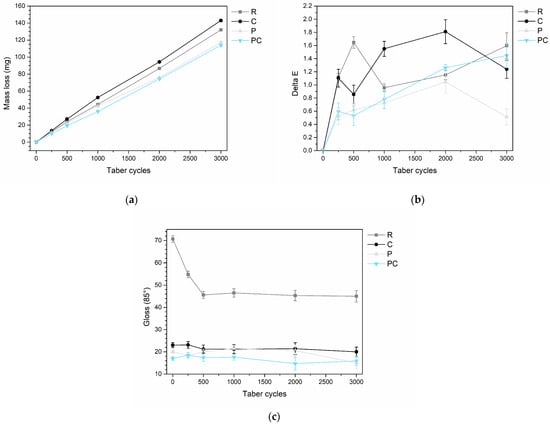
Figure 7.
Tracking (a) the mass loss and changes in (b) color and (c) gloss (//) of the samples over the course of the Taber test.
During the Taber test, the samples underwent color and gloss measurements to assess the aesthetic consistency of the coatings and, particularly, the contribution provided by the various bio-based pigments. Figure 7b illustrates the variation in color ΔE during the test, while Figure 7c depicts the evolution of gloss, measured longitudinal (//) to the wooden fibers. The color variation ΔE during the test appears to be somewhat incidental, with absolutely limited extent, always below 2 units, indicating the chromatic consistency of the coatings. They do not undergo significant color changes following the abrasive processes. Similarly, the gloss values of the three composite coatings remain almost constant, with variations in the order of the unit. Conversely, the reflectance values of sample R tend to decrease from ≈70 to ≈45 units, due to the increase in roughness induced by the abrasive process.
Thus, the Taber test once again confirms the excellent protective functions of the PA11-based filler. Importantly, it also assures that the sustainable coloring process of the filler does not compromise its strengthening potential but imparts long-lasting aesthetic features to the coating. The spreading process of the filler following abrasion efforts suggests an effective self-lubricating phenomenon, resulting in a consequent reduction in the friction coefficient. This functionality is another characteristic expressed by PA11 powder in the literature [].
Hence, the experimental setup depicted in Figure 8a, as previously described in Section 2, was utilized to assess the influence of various fillers on altering the static friction coefficient of the paint. The static coefficient of friction, defined as COF, was determined by the ratio of the minimum tangential force FT, required to initiate motion between the two surfaces in contact (i.e., the sample and the gray cast iron support), divided by the applied normal force FN. The tangential force is obtained from the product of the mean shear stress, τm, required to separate the contacting asperities, and the actual contact area, Ar [,]. The coefficient of friction, defined as COF, can be represented by the following Equation (2):
COF = (τm × Ar)/FN
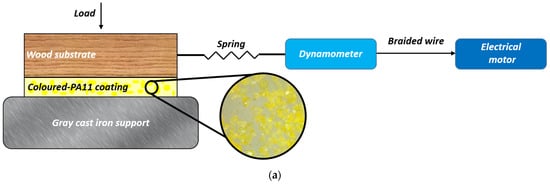
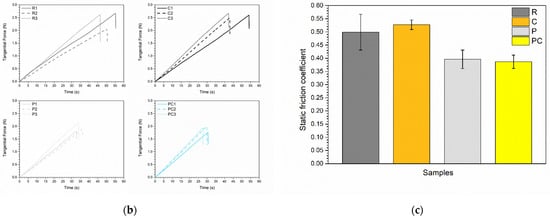
Figure 8.
(a) diagram illustrating the experimental configuration used for measuring the static friction coefficients (modified from []), with (b) the resulting tangential force measurements results and (c) the static friction coefficient outcomes.
Typically, the mean shear stress (τm) is attributed to the strength of adhesive bonds formed between the contacting asperities. However, the presence of hard and uneven particles can introduce an abrasive element through localized plastic deformation phenomena [,].
In consideration of Equation (2), given that the applied normal force FN remains constant during the measurements, the variation observed among the four series of samples stems from a modification of the product between the mean shear stress τm and the actual contact area Ar, i.e., the tangential force FT. The four graphs in Figure 8b depict the results of the measurements, showcasing the peak tangential force required to initiate sliding of the sample on the gray cast iron support. The decreased tangential force evident in samples P and PC correlates with a diminished average coefficient of friction (COF) value, as depicted in Figure 8c. Indeed, in samples P and PC the slip occurs in less time, accompanied by a lower peak tangential force and consequently a reduced coefficient of friction (COF). This occurrence can be linked to the plastic deformation phenomena of the PA11-based filler, as described earlier, which result in a significant reduction in the mean shear stress τm. Similar behaviors have been investigated for wax-based additives [,], and stainless-steel flakes [], specifically engineered to deform under stress and mitigate surface friction phenomena. While the coefficient of friction (COF) values of samples R and C are comparable, the incorporation of PA11-based powders leads to a reduction in the friction coefficient of approximately 21% and 22% in samples P and PC, respectively. Their coefficient of friction (COF) values align with the observations reported in the previous literature regarding the friction and wear characteristics of friction materials [].
Once more, the results underscore that the coloring process has no effect on the physical characteristics of the PA11-based filler, maintaining its plastic behavior under stress unchanged.
Despite its propensity to undergo plastic deformation under specific shear stresses, polyamide 11 is valued for its strength and has been demonstrated to be capable of slightly increasing the hardness of acrylic paints []. Consequently, the samples underwent the Buchholz hardness test, with the results depicted in Figure 9. The graph displays the average length of the indentations made by the instrument’s indenter, directly correlating with the Buchholz hardness value. The acrylic matrix exhibits notable softness, rendering it susceptible to indentation penetration. Consequently, the recorded hardness values are relatively low, averaging less than 50 on the Buchholz scale. Turmeric powder fails to significantly enhance this aspect; indeed, samples R and C yield comparable results in both COF and Buchholz hardness measurements. Therefore, the role of turmeric powder remains purely aesthetic. On the other hand, as previously demonstrated, colored PA11 powders not only serve as a pigment but also leverage the physical properties of the polyamide 11 from which they are derived. In fact, the average length of the indentations in samples P and PC decreases significantly, by approximately 10% compared to sample R. This average decrease in the length of indentations indicates a rise in surface hardness. Nevertheless, this augmentation in hardness is not deemed substantial as it still falls below the value of 50 on the Buchholz scale. Essentially, PA11 powders do demonstrate elevated hardness in comparison to the pure acrylic matrix of the coating. However, they are incapable of enhancing the hardness of the entire coating system, even at higher concentrations, as demonstrated in the other literature []. Finally, in this instance, the performances of samples P and PC are nearly identical, confirming the preservation of the favorable mechanical properties of the PA11 powder even after undergoing the sustainable coloring process using turmeric extracts.
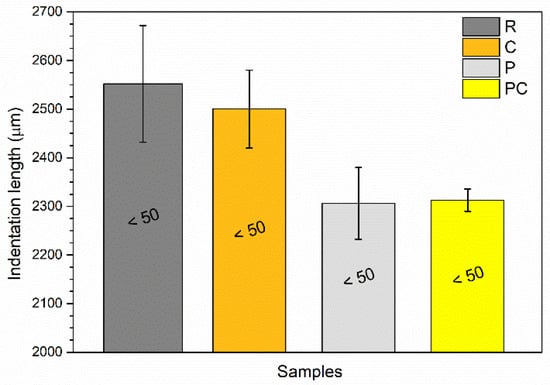
Figure 9.
The mean dimensions of indentation imprints recorded during Buchholz hardness assessments, paired with their respective Buchholz hardness determinations.
Ultimately, these tests underscore the significant disparity between the functions of turmeric powder and colored PA11. While the former serves solely as a bio-based pigment, the latter not only imparts a specific color to the coating but also introduces reinforcing effects characteristic of polyamide 11. The various tests validate the strengthening performances inherent in PA11 powders, as previously documented in the literature [,], and importantly, demonstrate how these properties remain unaffected by the coloring process. Thus, this process, designed to impart a specific color to PA11 powders in the simplest and most sustainable manner possible, emerges as a promising method capable of preserving the diverse typical functions of polyamide 11.
3.3. Color Stability and Aesthetic Durability of the Colored PA11-Based Additive
The coloring method that prioritizes ecological sustainability has demonstrated no adverse impact on the PA11-based filler’s physical characteristics. Thus, it becomes imperative to ensure the longevity of the additive’s color and assess its performance in harsh conditions, such as those expressed by atmospheric agents. Notably, research has extensively highlighted the vulnerability of pigments sourced from turmeric to photo degradation [,,] upon exposure to solar radiation. Indeed, natural and bio-based pigments frequently exhibit a notable susceptibility to both physical and chemical degradation when subjected to sunlight exposure [], greatly constraining their applicability in protective coatings []. Figure 10 depicts the aesthetic transformation of the different coating series after exposure to 50 h of UV-B radiation. The uncovered wooden panel experiences a significant alteration in appearance, darkening notably. This occurrence is well-documented in the literature and attributed to the poor resistance of the cellulose, hemicellulose, and lignin components comprising wood, which undergo pronounced photo oxidative degradation triggered by solar radiation [,,]. The presence of acrylic paint strongly restricts this phenomenon, as evidenced by the consistent aesthetic appearance of the reference sample R. Indeed, acrylic paints are renowned for their exceptional capacity to withstand UV light [,]. Nonetheless, a slight darkening is still evident, primarily attributed to the degradation, albeit limited, of the wooden substrate []. The prior literature [] has illustrated how transparent acrylic paints are unable to completely counteract the effects of photo oxidation in wood, a fact easily observable due to the transparency of the protective layer. On the other hand, sample C displays a reduction in the intensity of its orange hue, attributed to the degradation of the pigment derived from turmeric, as described earlier. Precisely, the three primary curcuminoids–curcumin, demethoxycurcumin, and bis-demethoxycurcumin–experience degradation processes characterized by the oxidative cleavage of their conjugated alkyl structures [], resulting in the subsequent fading of their color components []. On the contrary, sample P exhibits commendable durability, akin to the reference sample R. Indeed, PA11 powders have previously shown remarkable durability, indicating minimal degradation when subjected to harsh radiation like UV-B radiation []. However, the appearance of sample PC post-test suggests that the turmeric-derived pigment fails to provide adequate aesthetic consistency under UV-B radiation. Notably, the sample nearly loses its yellow hue entirely. This observation confirms that the sustainable coloring process involves extracting pure curcuminoids from turmeric powder, whose color significantly fades under aggressive radiation. As a result, the outdoor exposure of such functional pigments poses a notable technological challenge and certainly serves as a general constraint on the widespread utilization of bio-based dyes in paints.

Figure 10.
Modification of the visual aspect of both the wooden panel and the coated samples following exposure to UV-B radiation.
Thus, to quantitatively assess the aesthetic alterations caused by UV-B radiation, gloss and color measurements were conducted on the samples throughout the exposure test. Figure 11a illustrates the progression of gloss levels (//) across the various samples. Each exhibits a marginal decrease of equal magnitude. This occurrence is linked to limited photodegradation processes of the acrylic resin, a phenomenon previously noted in the existing literature [,]. Hence, significant alterations in surface reflectance are not observed in the samples. However, the decay is primarily evident through the color changes in the coatings, as previously observed in Figure 10. This is further quantitatively demonstrated by the graph in Figure 11b, which depicts the evolution of the color difference (ΔE) throughout the test. While the wooden substrate demonstrates the quickest and most pronounced color change, sample R displays a diminished aesthetic variation, tending to stabilize between 25 h and 50 h of exposure to UV-B radiation. As evident from the images in Figure 10, sample P follows a trend akin to that of the pure acrylic matrix, indicating the favorable performance of the PA11-based filler. Conversely, the turmeric in sample C induces a notable color alteration, particularly evident during the initial monitoring stage within the first 5 h of exposure. This suggests an almost immediate decay of the pigment. Lastly, sample PC exhibits a significant color alteration, noticeable within the initial h of UV-B radiation exposure. The intensity of this aesthetic change is greater than what was observed in sample C, as the PA11 powders were colored with pure turmeric extract, with a high content of curcuminoids, highly sensitive to color fading due to UV-B radiation. Examining the graphs depicting the evolutions of the individual color coordinates L*, a*, and b* (Figure 11c, Figure 11d, and Figure 11e, respectively), it becomes apparent that the color variation ΔE in sample PC primarily stems from the elimination of the green hue (a* trending towards 0) and the reduction in the yellow tone (b* significantly diminished). These two coordinates (a* = 2.1 ± 0.1 and b* = 25.9 ± 0.2) eventually attain values consistent with those of samples R and P, confirming the near-total disappearance of the yellow pigment extracted from turmeric.

Figure 11.
Evolution of (a) gloss (//), (b) color change, (c) L* coordinate, (d) a* coordinate and (e) b* coordinate, during the UV-B radiation exposure test.
These analyses have thus underscored the primary challenge linked to the utilization of bio-based pigments, notably their diminished chromatic stability under solar radiation. This issue becomes particularly pronounced when pure extracts are employed to color a material, as exemplified by the PA11 powders colored with turmeric extracts.
Yet another potential challenge for pigments lies in their susceptibility to various liquid solutions, which could undermine their coloring efficacy. Consequently, the samples were subjected to tests to assess their resistance to cold liquids. Figure 12a displays the gloss (//) values of the four series of samples when exposed to the six specific solutions utilized in the test. The solutions exert varied effects, differing even among the different samples. These effects include a general decrease in reflectance observed in the pure acrylic matrix of sample R, or an increase in gloss levels in the presence of turmeric (sample C). Conversely, samples P and PC demonstrate overall consistency in gloss, with minimal variations. This is attributed to the fact that PA11-based powders do not undergo significant alterations affecting their mattifying properties. Additionally, the turmeric extract itself does not seem to be affected by contact with the solutions, evident from the generally opaque appearance of the colored PA11 powders in sample PC. Figure 12b illustrates the impact of the solutions on the color of the coatings. According to the reference table provided in the standard [], all samples demonstrate excellent performance, with color fading levels categorized as 0–1, indicating either minimal or absent discoloration. The only notably aggressive solution appears to be the highly basic one at pH = 14, resulting in a substantial ΔE color change in the four samples. Samples R and P exhibit similar responses (ΔE = 10.4 ± 0.8 and 8.7 ± 0.8, respectively), suggesting a potential degradation of the resin induced by the basic pH. However, this does not significantly affect the PA11 powders. Conversely, the turmeric in sample C appears to undergo particular degradation, evident from a very high color change, equal to 64.7 ± 1.8 points. Indeed, other studies [,] in the literature have shown that curcumin maintains its stability under acidic conditions, while its color tends to deteriorate in alkaline environments. When exposed to acidic or neutral surroundings, curcumin predominantly exists in a keto form, resulting in a yellow hue. Conversely, under alkaline conditions, curcumin shifts to an enol form, leading to a change in color toward brownish-orange tones []. Additionally, research suggests that the degradation of curcumin is influenced by pH levels, giving rise to derivative products such as feruloyl methane []. These derivatives rapidly undergo condensation to form yellow-brown colored products []. The observed phenomenon appears to be less pronounced in sample PC. Nonetheless, the powders in this sample still undergo a significant color alteration, leading to a coating ΔE value of 16.3 ± 1.5 points.

Figure 12.
(a) transformation in gloss (//) levels and (b) variation in color of the samples as a consequence of the liquid resistance test.
Thus, the pigment derived from turmeric, utilized for coloring PA11 powders, experiences a degradation process akin to its source, albeit to a lesser degree. Figure 13 depicts the progression in the appearance of the four sample sets following exposure to the alkaline test solution. The yellowing observed in sample P closely resembles that of the reference sample R, indicating that PA11 powders have minimal impact on the coating’s color. Conversely, sample C undergoes a noticeable darkening, shifting towards red-brown tones, consistent with findings in the literature [,]. Lastly, sample PC displays a diminishing of its initial bright yellow hue, transitioning towards browner shades, indicative of the alteration of curcumins.
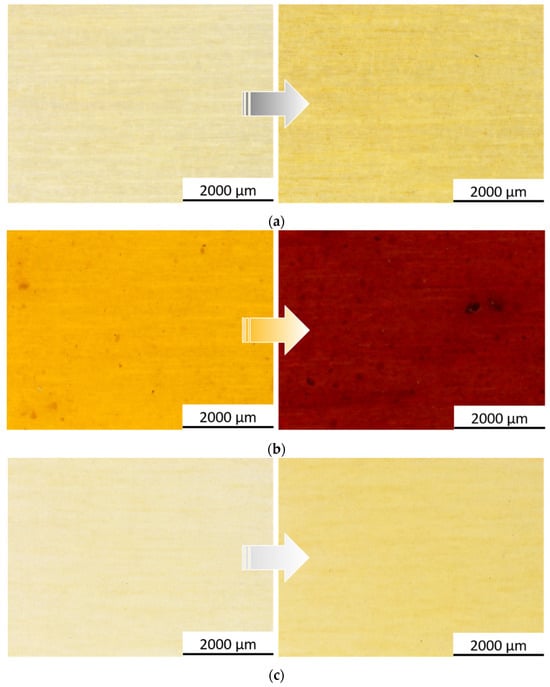
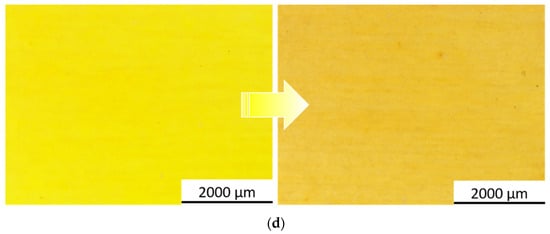
Figure 13.
Optical micrographs illustrating the transformation in appearance with the exposure to the alkaline solution with a pH of 14 of (a) sample R, (b) sample C, (c) sample P, and (d) sample PC.
Finally, the samples underwent water uptake tests to ensure that the addition of different fillers did not lead to the formation of defects in the polymer matrix, which could compromise the barrier properties of the coating. Figure 14a presents the results of the experiment, showing the evolution of water absorption phenomena observed during the test. Additionally, the chart includes a line representing the performance of the wooden base, serving as a benchmark to highlight the insulating properties of the four groups of coatings. As expected, the wooden panel demonstrates clear and immediate water absorption, characteristic of this material []. The insulating behavior of samples R, P, and PC exhibits remarkable similarity. This underscores how PA11-based powders, whether colored or not, demonstrate excellent compatibility with the acrylic resin. This affirmation aligns with the assumptions proposed by the images in Figure 6: the interface between filler and polymer matrix possesses high surface energy, effectively preventing the penetration of water molecules. In contrast, sample C displays a notably greater increase in water uptake during the initial 24 h of testing: at 24 h it reveals water uptake of 315 ± 21 g/cm2, against the 181 ± 11, 160 ± 11 and 174 ± 14 g/cm2 of samples R, P and PC, respectively. This phenomenon is followed by a trend similar to that of the other samples. This observation suggests that turmeric powders, with their intricate geometry and occasionally large dimensions, introduce effective defects in the coating. These defects create preferential sites for water percolation at the interface with the acrylic matrix. This issue becomes more significant when considering that sample C generally displays higher roughness values compared to the other three series of coatings (see Figure 5b). Interestingly, some studies in the literature suggest a correlation between increased roughness and improved hydrophobicity characteristics of a surface [,]. However, in this instance, sample C demonstrates the opposite effect: despite its higher roughness, its barrier properties are diminished, indicating a hydrophilic rather than hydrophobic behavior induced by turmeric. Alternatively, the turmeric pigment can be employed to color PA11 powder, thereby imparting a distinct color to the coating, without compromising its protective properties. Figure 14b,c illustrate the alterations in color and gloss (//) of the samples, respectively, following the water uptake test. Generally, the color appears to remain relatively stable even after prolonged contact with water, except in the case of high turmeric content, as observed in sample C. This trend is similar to what was previously observed in the graph from Figure 12b, where, for instance, NaCl caused a ΔE color change of 3.0 ± 0.4 points. However, in this instance, the color change is slightly more pronounced (3.8 ± 0.5), given the extended exposure to the liquid (100 h compared to 24 h in the cold liquid test). Notably, sample PC sample exhibits almost negligible color change (1.1 ± 0.2), similar to samples R and P (0.7 ± 0.1 and 0.8 ± 0.1, respectively). Additionally, samples P and PC exhibit consistent gloss values (1.2 ± 0.1 and 0.5 ± 0.1, respectively), attributed to the effective mattifying properties of the PA11-based powders. Ultimately, it can be concluded that the sustainable coloring process has endowed the PA11 powders with color and appearance that remain stable even after the coating comes into contact with water. In contrast, simple turmeric leads to significant aesthetic variations under similar conditions.
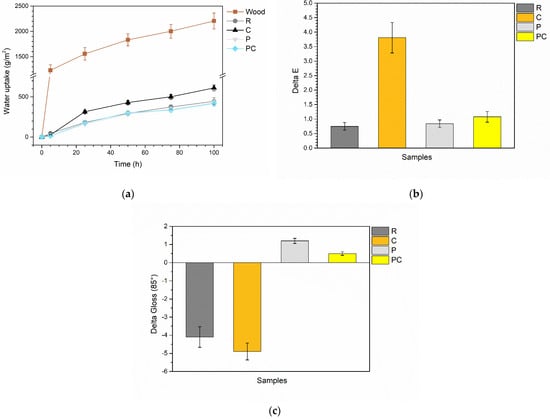
Figure 14.
(a) monitoring the water absorption by the coatings during the test, resulting in subsequent final alterations in (b) color and (c) gloss.
In conclusion, these tests effectively distinguished the behavior of samples C and PC when exposed to harsh environments, emphasizing the superior aesthetic consistency of the powders colored with turmeric extracts. While sunlight exposure poses a significant challenge for the pigmentation of coatings, a well-known issue for all natural organic dyes, contact with various liquids has revealed critical drawbacks in the use of turmeric powder. This inclusion introduces defects in the coating, resulting in a reduction of its barrier properties. In contrast, the colored PA11 powders not only maintain a certain aesthetic consistency but also leverage the functionality of polyamide 11 without compromising the protective features of the acrylic matrix.
4. Conclusions
This study has revealed a straightforward, cost-effective, and notably sustainable process for harnessing the coloring potential of turmeric powder and coloring PA11-based fillers. These can be utilized as multifunctional pigments for wood coatings. By incorporating this additive into a wood paint, the study demonstrated its dual effect on enhancing the aesthetics of the final composite layer and leveraging the beneficial protective properties inherent to polyamide 11.
Precisely, although turmeric provides vibrant coloration, microscopic analysis has revealed that its inconsistent and large granule size can cause morphological changes in the coating, potentially resulting in defects. In contrast, colored PA11 powders induce a distinct color transformation in the coating, functioning as a bio-based pigment. Additionally, they serve as a matting additive to enhance aesthetic properties without strongly altering the roughness of the final layer.
Multiple tests underscore the substantial contrast in the roles of turmeric powder and colored PA11 concerning the mechanical properties of the coating. While turmeric powder solely acts as a bio-based pigment, colored PA11 offers additional reinforcing effects inherent to polyamide 11. The diverse tests confirm the reinforcing capabilities intrinsic to PA11 powders, which enhance abrasion resistance, mitigate surface friction phenomena, and elevate surface hardness of the composite coating. Moreover, the results illustrate how these properties remain unaffected by the sustainable coloring process employed on the PA11 powders.
Finally, subjecting the samples to potentially hazardous conditions, such as UV-B radiation exposure and prolonged contact with various solutions, further emphasized the superior aesthetic consistency of the powders colored with turmeric extracts compared to simple turmeric powder. Particularly, contact with different liquids, such as water and NaOH solutions, exposed critical drawbacks in the use of turmeric powder, leading to a reduction in the coating’s barrier properties and demonstrating a high tendency for color fading. Conversely, the colored PA11 powders not only uphold a certain aesthetic consistency but also exploit the functionality of polyamide 11 without compromising the protective features of the acrylic matrix.
Ultimately, the study unveils the potential of combining the exceptional coloring properties of turmeric with the diverse strengthening functions of polyamide 11 to create a multifunctional pigment for wood paints. This pigment not only offers adequate protection but also aligns with current eco-requirements, thus contributing to the sustainability of the coatings industry.
Author Contributions
Conceptualization, M.C. and S.R.; methodology, M.C. and S.R.; investigation, M.C.; data curation, M.C. and S.R.; writing-original draft preparation, M.C.; writing-review and editing, M.C. and S.R.; supervision, S.R. All authors have read and agreed to the published version of the manuscript.
Funding
The publication was created with the co-financing of the European Union–FSE-REACT-EU, PON Research and Innovation 2014-2020 DM1062/2021.
Institutional Review Board Statement
Not applicable.
Informed Consent Statement
Not applicable.
Data Availability Statement
The data presented in this study are available on request from the corresponding author. The data are not publicly available due to the absence of an institutional repository.
Acknowledgments
The authors greatly acknowledge the contributions of Stefano Di Blase (ICA Group, Civitanova Marche, MC, Italy) for the paint supply. Moreover, special thanks should be given to Alberto Pinzo (Garzanti Specialties, Milan, Italy) and Sergi Borsani and Andrea Mannella (Grolman Group, Merate, MB, Italy) regarding the turmeric and the PA11 powders supply, respectively.
Conflicts of Interest
The authors declare no conflicts of interest.
References
- Khanna, A.S. High-Performance Organic Coatings; Elsevier: Amsterdam, The Netherlands, 2008. [Google Scholar]
- Kandi, S.G.; Panahi, B.; Zoghi, N. Impact of surface texture from fine to coarse on perceptual and instrumental gloss. Prog. Org. Coat. 2022, 171, 107028. [Google Scholar] [CrossRef]
- Makhlouf, A.S.H. Handbook of Smart Coatings for Materials Protection; Elsevier: Amsterdam, The Netherlands, 2014. [Google Scholar]
- Fotovvati, B.; Namdari, N.; Dehghanghadikolaei, A. On coating techniques for surface protection: A review. J. Manuf. Mater. Process. 2019, 3, 28. [Google Scholar] [CrossRef]
- Zareanshahraki, F.; Mannari, V. Formulation and optimization of radiation-curable nonisocyanate polyurethane wood coatings by mixture experimental design. J. Coat. Technol. Res. 2021, 18, 695–715. [Google Scholar] [CrossRef]
- Bansal, R.; Nair, S.; Pandey, K.K. UV resistant wood coating based on zinc oxide and cerium oxide dispersed linseed oil nano-emulsion. Mater. Today Commun. 2022, 30, 103177. [Google Scholar] [CrossRef]
- Jirouš-Rajković, V.; Miklečić, J. Enhancing weathering resistance of wood—A review. Polymers 2021, 13, 1980. [Google Scholar] [CrossRef] [PubMed]
- Veigel, S.; Grüll, G.; Pinkl, S.; Obersriebnig, M.; Müller, U.; Gindl-Altmutter, W. Improving the mechanical resistance of waterborne wood coatings by adding cellulose nanofibres. React. Funct. Polym. 2014, 85, 214–220. [Google Scholar] [CrossRef]
- Hochmańska-Kaniewska, P.; Janiszewska, D.; Oleszek, T. Enhancement of the properties of acrylic wood coatings with the use of biopolymers. Prog. Org. Coat. 2022, 162, 106522. [Google Scholar] [CrossRef]
- Miri Tari, S.M.; Tarmian, A.; Azadfallah, M. Improving fungal decay resistance of solvent and waterborne polyurethane-coated wood by free and microencapsulated thyme essential oil. J. Coat. Technol. Res. 2022, 19, 959–966. [Google Scholar] [CrossRef]
- Nikolic, M.; Lawther, J.M.; Sanadi, A.R. Use of nanofillers in wood coatings: A scientific review. J. Coat. Technol. Res. 2015, 12, 445–461. [Google Scholar] [CrossRef]
- Janesch, J.; Czabany, I.; Hansmann, C.; Mautner, A.; Rosenau, T.; Gindl-Altmutter, W. Transparent layer-by-layer coatings based on biopolymers and CeO2 to protect wood from UV light. Prog. Org. Coat. 2020, 138, 105409. [Google Scholar] [CrossRef]
- Cheumani Yona, A.M.; Žigon, J.; Ngueteu Kamlo, A.; Pavlič, M.; Dahle, S.; Petrič, M. Preparation, Surface Characterization, and Water Resistance of Silicate and Sol-Silicate Inorganic–Organic Hybrid Dispersion Coatings for Wood. Materials 2021, 14, 3559. [Google Scholar] [CrossRef] [PubMed]
- Yang, J.; Li, H.; Yi, Z.; Liao, M.; Qin, Z. Stable superhydrophobic wood surface constracting by KH580 and nano-Al2O3 on polydopamine coating with two process methods. Colloids Surf. A Physicochem. Eng. Asp. 2022, 637, 128219. [Google Scholar] [CrossRef]
- Duan, X.; Liu, S.; Huang, E.; Shen, X.; Wang, Z.; Li, S.; Jin, C. Superhydrophobic and antibacterial wood enabled by polydopamine-assisted decoration of copper nanoparticles. Colloids Surf. A Physicochem. Eng. Asp. 2020, 602, 125145. [Google Scholar] [CrossRef]
- Janin, G.; Gonçalez, J.C.; Ananías, R.A.; Charrier, B.; Silva, G.F.d.; Dilem, A. Aesthetics Appreciation of Wood Colour and Patterns by Colorimetry. Part 1. Colorimetry Theory for the CIELab System; Departamento de Engenharia da Madeira, da Universidade de Bío-Bío em Concepción: Concepción, Chile, 2001. [Google Scholar]
- Wiemann, M.C. Characteristics and availability of commercially important woods. In Forest Products Laboratory. Wood Handbook: Wood as an Engineering Material; United States Department of Agriculture Forest Service: Madison, WI, USA, 2010. [Google Scholar]
- Yan, X.; Chang, Y.; Qian, X. Effect of the concentration of pigment slurry on the film performances of waterborne wood coatings. Coatings 2019, 9, 635. [Google Scholar] [CrossRef]
- Calovi, M.; Zanardi, A.; Rossi, S. Recent Advances in Bio-Based Wood Protective Systems: A Comprehensive Review. Appl. Sci. 2024, 14, 736. [Google Scholar] [CrossRef]
- Teaca, C.A.; Roşu, D.; Mustaţă, F.; Rusu, T.; Roşu, L.; Roşca, I.; Varganici, C.-D. Natural bio-based products for wood coating and protection against degradation: A Review. BioResources 2019, 14, 4873–4901. [Google Scholar] [CrossRef]
- Calovi, M.; Rossi, S. Impact of High Concentrations of Cellulose Fibers on the Morphology, Durability and Protective Properties of Wood Paint. Coatings 2023, 13, 721. [Google Scholar] [CrossRef]
- Pacheco, C.M.; Cecilia, B.A.; Reyes, G.; Oviedo, C.; Fernández-Pérez, A.; Elso, M.; Rojas, O.J. Nanocomposite additive of SiO2/TiO2/nanocellulose on waterborne coating formulations for mechanical and aesthetic properties stability on wood. Mater. Today Commun. 2021, 29, 102990. [Google Scholar] [CrossRef]
- Jusic, J.; Tamantini, S.; Romagnoli, M.; Vinciguerra, V.; Di Mattia, E.; Zikeli, F.; Cavalera, M.; Scarascia Mugnozza, G. Improving sustainability in wood coating: Testing lignin and cellulose nanocrystals as additives to commercial acrylic wood coatings for bio-building. iFOREST 2021, 14, 499. [Google Scholar] [CrossRef]
- Calovi, M.; Rossi, S. Comparative analysis of the advantages and disadvantages of utilizing spirulina-derived pigment as a bio-based colorant for wood impregnator. Coatings 2023, 13, 1154. [Google Scholar] [CrossRef]
- Calovi, M.; Rossi, S. Synergistic contribution of bio-based additives in wood paint: The combined effect of pigment deriving from spirulina and multifunctional filler based on carnauba wax. Prog. Org. Coat. 2023, 182, 107713. [Google Scholar] [CrossRef]
- Calovi, M.; Rossi, S. Exploring polyamide 11 as a novel renewable resource-based filler in wood paint: Investigating aesthetic aspects and durability impact of the composite coating. Prog. Org. Coat. 2024, 188, 108262. [Google Scholar] [CrossRef]
- Calovi, M.; Rossi, S. Eco-Friendly Multilayer Coating Harnessing the Functional Features of Curcuma-Based Pigment and Rice Bran Wax as a Hydrophobic Filler. Materials 2023, 16, 7086. [Google Scholar] [CrossRef] [PubMed]
- Bello, J.; Wood, R. Micro-abrasion of filled and unfilled polyamide 11 coatings. Wear 2005, 258, 294–302. [Google Scholar] [CrossRef]
- Akarchariya, N.; Sirilun, S.; Julsrigival, J.; Chansakaowa, S. Chemical profiling and antimicrobial activity of essential oil from Curcuma aeruginosa Roxb., Curcuma glans K. Larsen & J. Mood and Curcuma cf. xanthorrhiza Roxb. collected in Thailand. Asian Pac. J. Trop. Biomed. 2017, 7, 881–885. [Google Scholar]
- Jayaprakasha, G.; Rao, L.J.M.; Sakariah, K. Chemistry and biological activities of C. longa. Trends Food Sci. Technol. 2005, 16, 533–548. [Google Scholar] [CrossRef]
- Itokawa, H.; Shi, Q.; Akiyama, T.; Morris-Natschke, S.L.; Lee, K.-H. Recent advances in the investigation of curcuminoids. Chin. Med. 2008, 3, 11. [Google Scholar] [CrossRef] [PubMed]
- Ahmad, R.S.; Hussain, M.B.; Sultan, M.T.; Arshad, M.S.; Waheed, M.; Shariati, M.A.; Plygun, S.; Hashempur, M.H. Biochemistry, safety, pharmacological activities, and clinical applications of turmeric: A mechanistic review. eCAM 2020, 2020, 7656919. [Google Scholar] [CrossRef] [PubMed]
- Amalraj, A.; Pius, A.; Gopi, S.; Gopi, S. Biological activities of curcuminoids, other biomolecules from turmeric and their derivatives–A review. J. Tradit. Complement. Med. 2017, 7, 205–233. [Google Scholar] [CrossRef] [PubMed]
- Lykidou, S.; Pashou, M.; Vouvoudi, E.; Nikolaidis, N. Study on the dyeing properties of curcumin on natural and synthetic fibers and antioxidant and antibacterial activities. Fibers Polym. 2021, 22, 3336–3342. [Google Scholar] [CrossRef]
- Priyadarsini, K.I. The chemistry of curcumin: From extraction to therapeutic agent. Molecules 2014, 19, 20091–20112. [Google Scholar] [CrossRef] [PubMed]
- Jiang, T.; Ghosh, R.; Charcosset, C. Extraction, purification and applications of curcumin from plant materials-A comprehensive review. Trends Food Sci. Technol. 2021, 112, 419–430. [Google Scholar] [CrossRef]
- Paulucci, V.P.; Couto, R.O.; Teixeira, C.C.; Freitas, L.A.P. Optimization of the extraction of curcumin from Curcuma longa rhizomes. Rev. Bras. Farmacogn. 2013, 23, 94–100. [Google Scholar] [CrossRef]
- Takenaka, M.; Ohkubo, T.; Okadome, H.; Sotome, I.; Itoh, T.; Isobe, S. Effective extraction of curcuminoids by grinding turmeric (Curcuma longa) with medium-chain triacylglycerols. Food Sci. Technol. Res. 2013, 19, 655–659. [Google Scholar] [CrossRef]
- Ali, I.; Haque, A.; Saleem, K. Separation and identification of curcuminoids in turmeric powder by HPLC using phenyl column. Anal. Methods 2014, 6, 2526–2536. [Google Scholar] [CrossRef]
- Popuri, A.K.; Pagala, B. Extraction of curcumin from turmeric roots. Int. J. Innov. Res. Stud. 2013, 2, 289–299. [Google Scholar]
- Horosanskaia, E.; Yuan, L.; Seidel-Morgenstern, A.; Lorenz, H. Purification of curcumin from ternary extract-similar mixtures of curcuminoids in a single crystallization step. Crystals 2020, 10, 206. [Google Scholar] [CrossRef]
- Pan, Y.; Ju, R.; Cao, X.; Pei, H.; Zheng, T.; Wang, W. Optimization extraction and purification of biological activity curcumin from Curcuma longa L by high-performance counter-current chromatography. J. Sep. Sci. 2020, 43, 1586–1592. [Google Scholar] [CrossRef] [PubMed]
- Li, M.; Ngadi, M.O.; Ma, Y. Optimisation of pulsed ultrasonic and microwave-assisted extraction for curcuminoids by response surface methodology and kinetic study. Food Chem. 2014, 165, 29–34. [Google Scholar] [CrossRef] [PubMed]
- Kim, Y.-J.; Lee, H.J.; Shin, Y. Optimization and validation of high-performance liquid chromatography method for individual curcuminoids in turmeric by heat-refluxed extraction. J. Agric. Food Chem. 2013, 61, 10911–10918. [Google Scholar] [CrossRef] [PubMed]
- Lee, K.-J.; Ma, J.-Y.; Kim, Y.-S.; Kim, D.-S.; Jin, Y. High purity extraction and simultaneous high-performance liquid chromatography analysis of curcuminoids in turmeric. J. Appl. Biol. Chem. 2012, 55, 61–65. [Google Scholar] [CrossRef]
- Lampe, V.; Milobedzka, J. Studien über curcumin. Ber. Dtsch. Chem. Ges. 1913, 46, 2235–2240. [Google Scholar] [CrossRef]
- Venkateswarlu, S.; Ramachandra, M.S.; Subbaraju, G.V. Synthesis and biological evaluation of polyhydroxycurcuminoids. Bioorg. Med. Chem. 2005, 13, 6374–6380. [Google Scholar] [CrossRef] [PubMed]
- Rao, E.V.; Sudheer, P. Revisiting curcumin chemistry part I: A new strategy for the synthesis of curcuminoids. Indian J. Pharm. Sci. 2011, 73, 262. [Google Scholar] [PubMed]
- Balatinecz, J.J.; Kretschmann, D.E.; Leclercq, A. Achievements in the utilization of poplar wood–guideposts for the future. For. Chron. 2001, 77, 265–269. [Google Scholar] [CrossRef]
- Balatinecz, J.J.; Kretschmann, D.E. Properties and utilization of poplar wood. In Poplar Culture in North America; NRC Research Press: Ottawa, ON, Canada, 2001; pp. 277–291. ISBN 978-0-660-18145-5. [Google Scholar]
- ASTM D523-14; Standard Test Method for Specular Gloss. ASTM International: West Conshohocken, PA, USA, 2014; pp. 1–12.
- ASTM D4060; Standard Test Method for Abrasion Resistance of Organic Coatings by the Taber Abraser. ASTM International: West Conshohocken, PA, USA, 2010; pp. 1–13.
- Calovi, M.; Rossi, S. Olive pit powder as multifunctional pigment for waterborne paint: Influence of the bio-based filler on the aesthetics, durability and mechanical features of the polymer matrix. Ind. Crop. Prod. 2023, 194, 116326. [Google Scholar] [CrossRef]
- Federici, M.; Gialanella, S.; Leonardi, M.; Perricone, G.; Straffelini, G. A preliminary investigation on the use of the pin-on-disc test to simulate off-brake friction and wear characteristics of friction materials. Wear 2018, 410, 202–209. [Google Scholar] [CrossRef]
- ISO 2815-2000; Determinazione Della Durezza con il Metodo di Penetrazione Buchholz. UNI–Ente Nazionale Italiano di Unificazione: Roma, Italy, 2000; pp. 1–10.
- ASTM D4587-11(2019)e1; Standard Practice for Fluorescent UV-Condensation Exposures of Paint and Related Coatings. ASTM International: West Conshohocken, PA, USA, 2019; pp. 1–6.
- UNI EN 12720-14; Assessment of Surface Resistance to Cold Liquids. European Committee for Standardization: Brussels, Belgium, 2014; pp. 1–4.
- EN927-05; Paints and Varnishes–Coating Materials and Coating Systems for Exterior Wood–Part 5: Assessment of the Liquid Water Permeability. European Standard: Brussels, Belgium, 2005; pp. 1–18.
- ASTM-E308-18; Standard Practice for Computing the Colors of Objectives by Using the CIE System. ASTM International: West Conshohocken, PA, USA, 2018; pp. 1–45.
- Mokrzycki, W.; Tatol, M. Colour difference ∆E–A survey. Mach. Graph. Vis. 2011, 20, 383–411. [Google Scholar]
- Calovi, M.; Russo, F.; Rossi, S. Esthetic performance of thermochromic pigments in cataphoretic and sprayed coatings for outdoor applications. J. Appl. Polym. Sci. 2021, 138, 50622. [Google Scholar] [CrossRef]
- Kawada, J.; Kitou, M.; Mouri, M.; Mitsuoka, T.; Araki, T.; Lee, C.-H.; Ario, T.; Kitou, O.; Usuki, A. Morphology controlled PA11 bio-alloys with excellent impact strength. ACS Sustain. Chem. Eng. 2016, 4, 2158–2164. [Google Scholar] [CrossRef]
- Rajesh, J.J.; Bijwe, J.; Tewari, U. Abrasive wear performance of various polyamides. Wear 2002, 252, 769–776. [Google Scholar] [CrossRef]
- Calovi, M.; Rossi, S. The impact of stainless steel flakes as a novel multifunctional pigment for wood coatings. J. Coat. Technol. Res. 2024, 21, 1031–1047. [Google Scholar] [CrossRef]
- Sbardella, F.; Pronti, L.; Santarelli, M.L.; Asua Gonzàlez, J.M.; Bracciale, M.P. Waterborne acrylate-based hybrid coatings with enhanced resistance properties on stone surfaces. Coatings 2018, 8, 283. [Google Scholar] [CrossRef]
- Sahu, P.; Mahanwar, P.; Bambole, V. Effect of hollow glass microspheres and cenospheres on insulation properties of coatings. Pigm. Resin Technol. 2013, 42, 223–230. [Google Scholar] [CrossRef]
- Rabinowicz, E.; Tanner, R. Friction and wear of materials. J. Appl. Mech. 1966, 33, 479. [Google Scholar] [CrossRef]
- Hutchings, I.; Shipway, P. Tribology: Friction and Wear of Engineering Materials; Butterworth-Heinemann: Oxford, UK, 2017. [Google Scholar]
- Straffelini, G. A simplified approach to the adhesive theory of friction. Wear 2001, 249, 78–84. [Google Scholar] [CrossRef]
- Calovi, M.; Rossi, S. Evaluating the versatility of stainless steel flakes and magnetite powder as polyvalent additives for wood paints. J. Mater. Res. Technol. 2024, 29, 1010–1024. [Google Scholar] [CrossRef]
- Priyadarsini, K.I. Photophysics, photochemistry and photobiology of curcumin: Studies from organic solutions, bio-mimetics and living cells. J. Photochem. Photobiol. C Photochem. 2009, 10, 81–95. [Google Scholar] [CrossRef]
- Nardo, L.; Andreoni, A.; Masson, M.; Haukvik, T.; Tønnesen, H.H. Studies on curcumin and curcuminoids. XXXIX. Photophysical properties of bisdemethoxycurcumin. J. Fluoresc. 2011, 21, 627–635. [Google Scholar] [CrossRef] [PubMed]
- Jung, Y.N.; Hong, J. Changes in chemical properties and bioactivities of turmeric pigments by photo-degradation. AIMS Agric. Food 2021, 6, 754–767. [Google Scholar] [CrossRef]
- Groeneveld, I.; Kanelli, M.; Ariese, F.; van Bommel, M.R. Parameters that affect the photodegradation of dyes and pigments in solution and on substrate—An overview. Dyes Pigm. 2023, 210, 110999. [Google Scholar] [CrossRef]
- Calovi, M.; Rossi, S. From wood waste to wood protection: New application of black bio renewable water-based dispersions as pigment for bio-based wood paint. Prog. Org. Coat. 2023, 180, 107577. [Google Scholar] [CrossRef]
- Teacă, C.-A.; Roşu, D.; Bodîrlău, R.; Roşu, L. Structural Changes in Wood under Artificial UV Light Irradiation Determined by FTIR Spectroscopy and Color Measurements--A Brief Review. BioResources 2013, 8, 1478–1507. [Google Scholar] [CrossRef]
- Brischke, C.; Bayerbach, R.; Otto Rapp, A. Decay-influencing factors: A basis for service life prediction of wood and wood-based products. Wood Mater. Sci. Eng. 2006, 1, 91–107. [Google Scholar] [CrossRef]
- Chiantore, O.; Trossarelli, L.; Lazzari, M. Photooxidative degradation of acrylic and methacrylic polymers. Polymer 2000, 41, 1657–1668. [Google Scholar] [CrossRef]
- Kaczmarek, H.; Kamińska, A.; van Herk, A. Photooxidative degradation of poly(alkyl methacrylate)s. Eur. Polym. J. 2000, 36, 767–777. [Google Scholar] [CrossRef]
- Kropat, M.; Hubbe, M.A.; Laleicke, F. Natural, accelerated, and simulated weathering of wood: A review. BioResources 2020, 15, 9998. [Google Scholar] [CrossRef]
- Calovi, M.; Coroneo, V.; Palanti, S.; Rossi, S. Colloidal silver as innovative multifunctional pigment: The effect of Ag concentration on the durability and biocidal activity of wood paints. Prog. Org. Coat. 2023, 175, 107354. [Google Scholar] [CrossRef]
- Khurana, A.; Ho, C.-T. High performance liquid chromatographic analysis of curcuminoids and their photo-oxidative decomposition compounds in Curcuma longa L. J. Liq. Chromatogr. 1988, 11, 2295–2304. [Google Scholar] [CrossRef]
- Jitoe-Masuda, A.; Fujimoto, A.; Masuda, T. Curcumin: From chemistry to chemistry-based functions. Curr. Pharm. Des. 2013, 19, 2084–2092. [Google Scholar] [PubMed]
- Wulandari, A.; Sunarti, T.C.; Fahma, F.; Enomae, T. The potential of bioactives as biosensors for detection of pH. IOP Conf. Ser. Earth Environ. Sci. 2019, 460, 012034. [Google Scholar] [CrossRef]
- Pourreza, N.; Golmohammadi, H. Application of curcumin nanoparticles in a lab-on-paper device as a simple and green pH probe. Talanta 2015, 131, 136–141. [Google Scholar] [CrossRef] [PubMed]
- Anand, P.; Kunnumakkara, A.B.; Newman, R.A.; Aggarwal, B.B. Bioavailability of curcumin: Problems and promises. Mol. Pharm. 2007, 4, 807–818. [Google Scholar] [CrossRef] [PubMed]
- Tønnesen, H.H.; Másson, M.; Loftsson, T. Studies of curcumin and curcuminoids. XXVII. Cyclodextrin complexation: Solubility, chemical and photochemical stability. Int. J. Pharm. 2002, 244, 127–135. [Google Scholar] [CrossRef] [PubMed]
- Stankovic, I. Curcumin Chemical and TechnicalAssessment (CTA), 61st JECFA; Joint FAO/WHO Expert Committee on Food Additives (JECFA), Nfao: Rome, Italy, 2004.
- Zhou, M.; LI, F.; Chen, J.; Wu, Q.; Zou, Z. Research progress on natural bio-based encapsulation system of curcumin and its stabilization mechanism. Food Sci. Technol. 2022, 42, e78422. [Google Scholar] [CrossRef]
- Zhang, Y.; Jin, J.; Wang, S. Effects of resin and wax on the water uptake behavior of wood strands. Wood Fiber Sci. 2007, 39, 271–278. [Google Scholar]
- Yang, C.; Tartaglino, U.; Persson, B. Influence of surface roughness on superhydrophobicity. Phys. Rev. Lett. 2006, 97, 116103. [Google Scholar] [CrossRef] [PubMed]
- Maghsoudy-Louyeh, S.; Ju, H.; Tittmann, B. Surface roughness study in relation with hydrophilicity/hydrophobicity of materials using atomic force microscopy. AIP Conf. Proc. 2010, 1211, 1487–1492. [Google Scholar]
Disclaimer/Publisher’s Note: The statements, opinions and data contained in all publications are solely those of the individual author(s) and contributor(s) and not of MDPI and/or the editor(s). MDPI and/or the editor(s) disclaim responsibility for any injury to people or property resulting from any ideas, methods, instructions or products referred to in the content. |
© 2024 by the authors. Licensee MDPI, Basel, Switzerland. This article is an open access article distributed under the terms and conditions of the Creative Commons Attribution (CC BY) license (https://creativecommons.org/licenses/by/4.0/).